Page 152 of 376
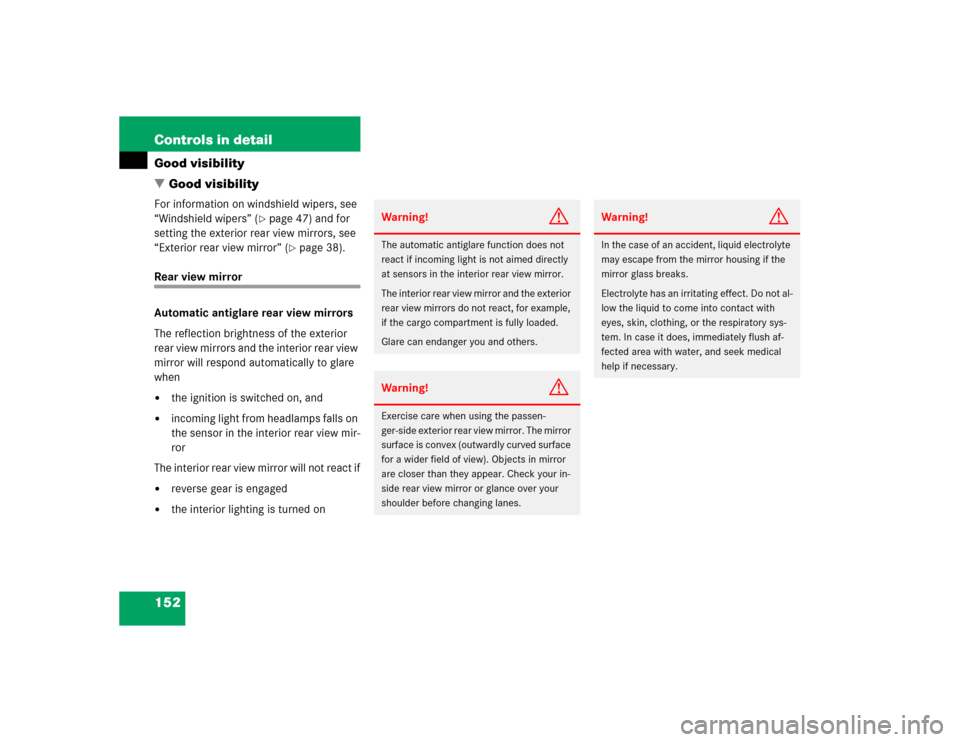
152 Controls in detailGood visibility
�Good visibilityFor information on windshield wipers, see
“Windshield wipers” (
�page 47) and for
setting the exterior rear view mirrors, see
“Exterior rear view mirror” (
�page 38).
Rear view mirror
Automatic antiglare rear view mirrors
The reflection brightness of the exterior
rear view mirrors and the interior rear view
mirror will respond automatically to glare
when �
the ignition is switched on, and
�
incoming light from headlamps falls on
the sensor in the interior rear view mir-
ror
The interior rear view mirror will not react if
�
reverse gear is engaged
�
the interior lighting is turned on
Warning!
G
The automatic antiglare function does not
react if incoming light is not aimed directly
at sensors in the interior rear view mirror.
The interior rear view mirror and the exterior
rear view mirrors do not react, for example,
if the cargo compartment is fully loaded.
Glare can endanger you and others.Warning!
G
Exercise care when using the passen-
ger-side exterior rear view mirror. The mirror
surface is convex (outwardly curved surface
for a wider field of view). Objects in mirror
are closer than they appear. Check your in-
side rear view mirror or glance over your
shoulder before changing lanes.
Warning!
G
In the case of an accident, liquid electrolyte
may escape from the mirror housing if the
mirror glass breaks.
Electrolyte has an irritating effect. Do not al-
low the liquid to come into contact with
eyes, skin, clothing, or the respiratory sys-
tem. In case it does, immediately flush af-
fected area with water, and seek medical
help if necessary.
Page 175 of 376
175 Controls in detail
Loading
�Loading
Roof rack
This vehicle is not intended to carry items
on its roof. Thus roof rails and any
roof-mounted devices must not be used.
Cargo compartment cover
1Rear seat bench cover
2Tailgate cover�
Pull cover1 out. Hook it into the
mountings on the rear seat bench.
�
Pull cover2 out. Hook it into the
mountings to the left and right of the
tailgate.Rolling up the cover
�
Grip the cover strap and remove it from
the mountings on both sides.
�
Guide it slowly back into place.
Warning!
G
Do not load items on the roof. It may cause
instability during some maneuvers which
could result in an accident.
Page 176 of 376
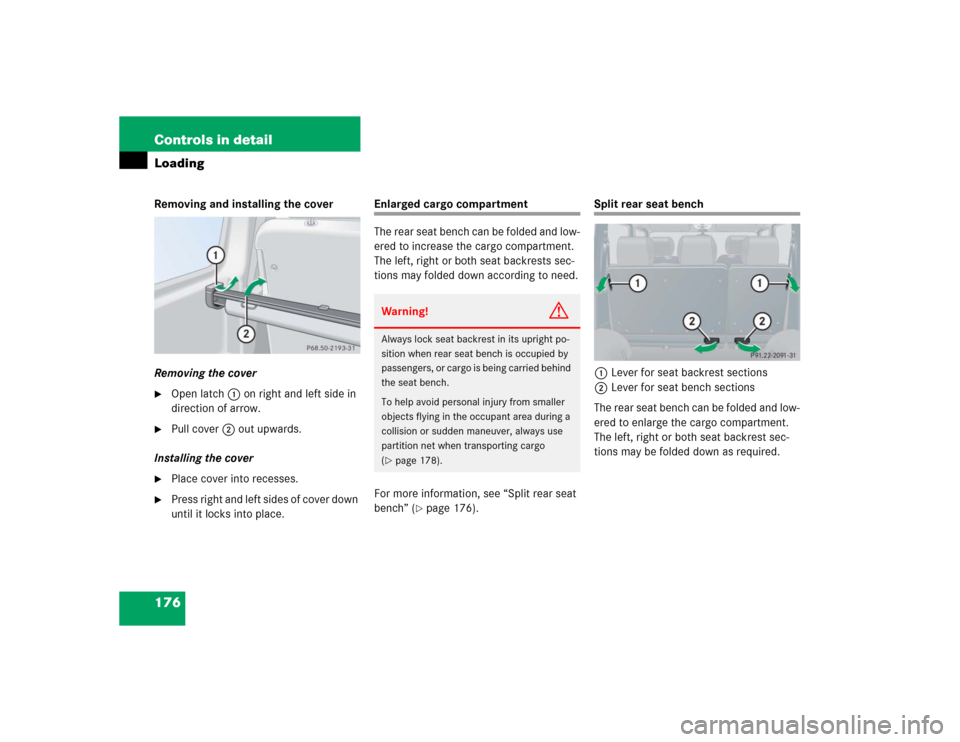
176 Controls in detailLoadingRemoving and installing the cover
Removing the cover�
Open latch1 on right and left side in
direction of arrow.
�
Pull cover2 out upwards.
Installing the cover
�
Place cover into recesses.
�
Press right and left sides of cover down
until it locks into place.
Enlarged cargo compartment
The rear seat bench can be folded and low-
ered to increase the cargo compartment.
The left, right or both seat backrests sec-
tions may folded down according to need.
For more information, see “Split rear seat
bench” (
�page 176).
Split rear seat bench
1Lever for seat backrest sections
2Lever for seat bench sections
The rear seat bench can be folded and low-
ered to enlarge the cargo compartment.
The left, right or both seat backrest sec-
tions may be folded down as required.
Warning!
G
Always lock seat backrest in its upright po-
sition when rear seat bench is occupied by
passengers, or cargo is being carried behind
the seat bench.
To help avoid personal injury from smaller
objects flying in the occupant area during a
collision or sudden maneuver, always use
partition net when transporting cargo
(�page 178).
Page 178 of 376
178 Controls in detailLoadingPartition net* (MB Accessory)
Use of the partition net is a particularly im-
portant safety factor when the vehicle is
loaded higher than the top of the seat
backrests with smaller objects.
While the partition net will help protect you
from smaller objects, it cannot prevent the
movement of large, heavier objects into
the passenger area in an accident. Such
items must be properly secured using the
cargo tie-down rings in the cargo compart-
ment floor.The partition net can be installed behind
the seat backrests of the rear seat bench,
or behind the front seats if the rear seat
bench is folded down.Installation behind rear seat bench
1Partition net
2Mounting
�
Fold the rear seat bench forward
(�page 176).
�
Hook partition net1 in mountings2
on both sides.
iInstallation can be performed by open-
ing the rear doors.
iThis cannot be done by folding the rear
seat backrest forward.
Page 180 of 376
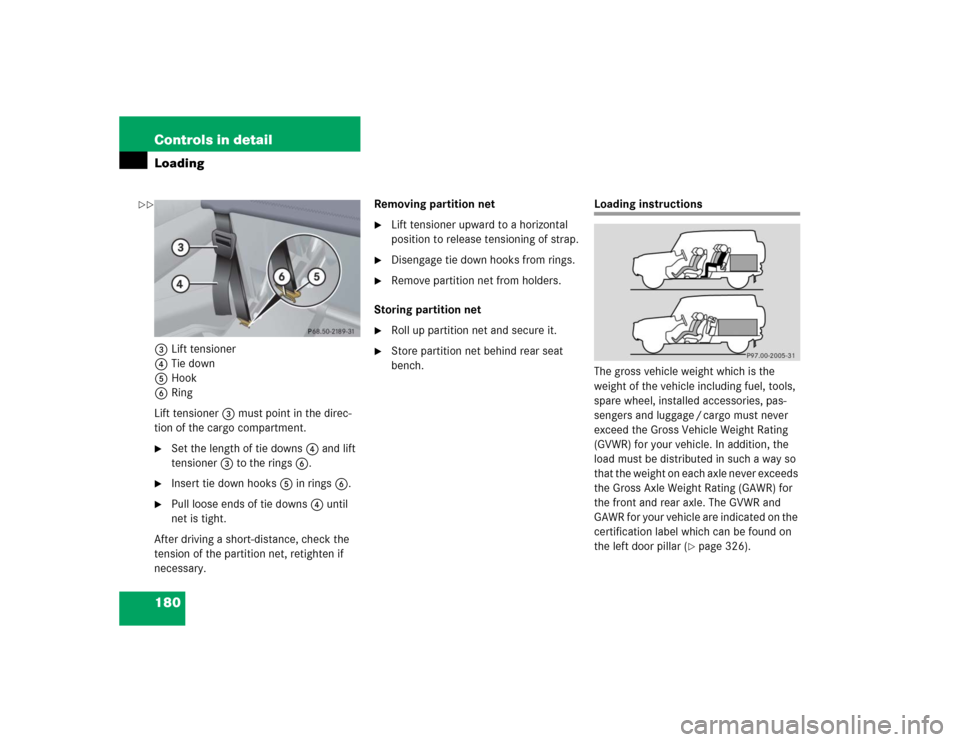
180 Controls in detailLoading3Lift tensioner
4Tie down
5Hook
6Ring
Lift tensioner3 must point in the direc-
tion of the cargo compartment.�
Set the length of tie downs4 and lift
tensioner3 to the rings6.
�
Insert tie down hooks5 in rings6.
�
Pull loose ends of tie downs4 until
net is tight.
After driving a short-distance, check the
tension of the partition net, retighten if
necessary.Removing partition net
�
Lift tensioner upward to a horizontal
position to release tensioning of strap.
�
Disengage tie down hooks from rings.
�
Remove partition net from holders.
Storing partition net
�
Roll up partition net and secure it.
�
Store partition net behind rear seat
bench.
Loading instructions
The gross vehicle weight which is the
weight of the vehicle including fuel, tools,
spare wheel, installed accessories, pas-
sengers and luggage / cargo must never
exceed the Gross Vehicle Weight Rating
(GVWR) for your vehicle. In addition, the
load must be distributed in such a way so
t h a t t h e w e i g h t o n e a c h a x l e n e v e r e x c e e d s
the Gross Axle Weight Rating (GAWR) for
the front and rear axle. The GVWR and
GAWR for your vehicle are indicated on the
certification label which can be found on
the left door pillar (
�page 326).
��
Page 181 of 376
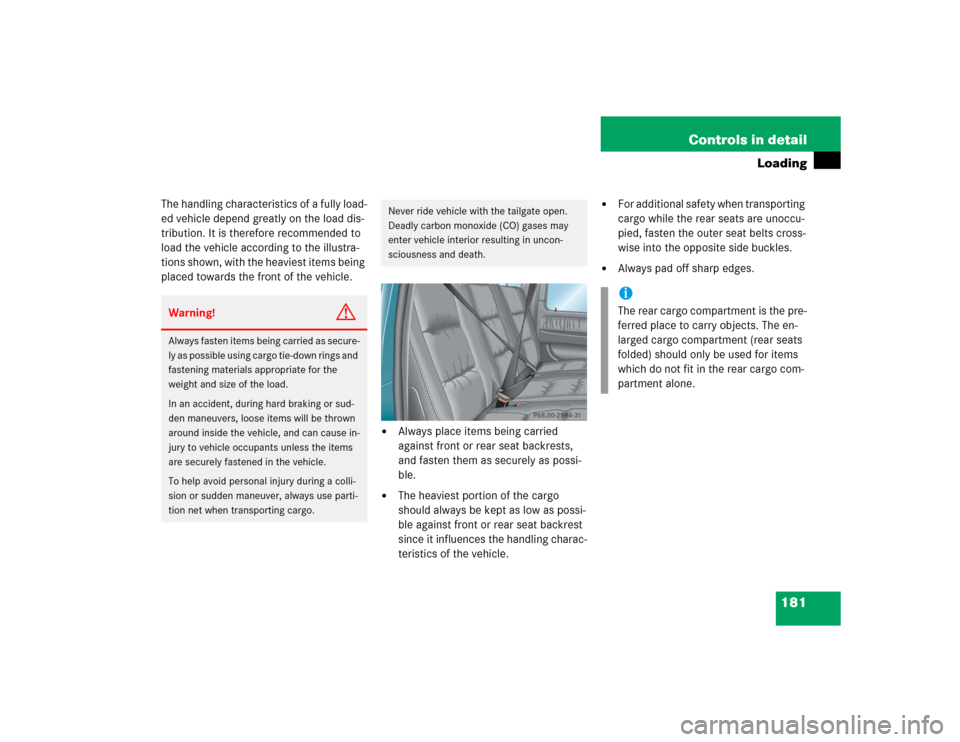
181 Controls in detail
Loading
The handling characteristics of a fully load-
ed vehicle depend greatly on the load dis-
tribution. It is therefore recommended to
load the vehicle according to the illustra-
tions shown, with the heaviest items being
placed towards the front of the vehicle.
�
Always place items being carried
against front or rear seat backrests,
and fasten them as securely as possi-
ble.
�
The heaviest portion of the cargo
should always be kept as low as possi-
ble against front or rear seat backrest
since it influences the handling charac-
teristics of the vehicle.
�
For additional safety when transporting
cargo while the rear seats are unoccu-
pied, fasten the outer seat belts cross-
wise into the opposite side buckles.
�
Always pad off sharp edges.
Warning!
G
Always fasten items being carried as secure-
ly as possible using cargo tie-down rings and
fastening materials appropriate for the
weight and size of the load.
In an accident, during hard braking or sud-
den maneuvers, loose items will be thrown
around inside the vehicle, and can cause in-
jury to vehicle occupants unless the items
are securely fastened in the vehicle.
To help avoid personal injury during a colli-
sion or sudden maneuver, always use parti-
tion net when transporting cargo.
Never ride vehicle with the tailgate open.
Deadly carbon monoxide (CO) gases may
enter vehicle interior resulting in uncon-
sciousness and death.
iThe rear cargo compartment is the pre-
ferred place to carry objects. The en-
larged cargo compartment (rear seats
folded) should only be used for items
which do not fit in the rear cargo com-
partment alone.
Page 182 of 376
182 Controls in detailLoadingCargo tie-down rings
The cargo compartment is provided with
four tie-down anchors.
Carefully secure cargo by applying even
load on all rings with rope of sufficient
strength to hold down the cargo.
Warning!
G
While the partition net will help protect you
from smaller objects, it cannot prevent the
movement of large, heavier objects into the
passenger area in an accident.
Such items must be properly secured using
the cargo tie-down rings in the cargo com-
partment floor.
Page 183 of 376
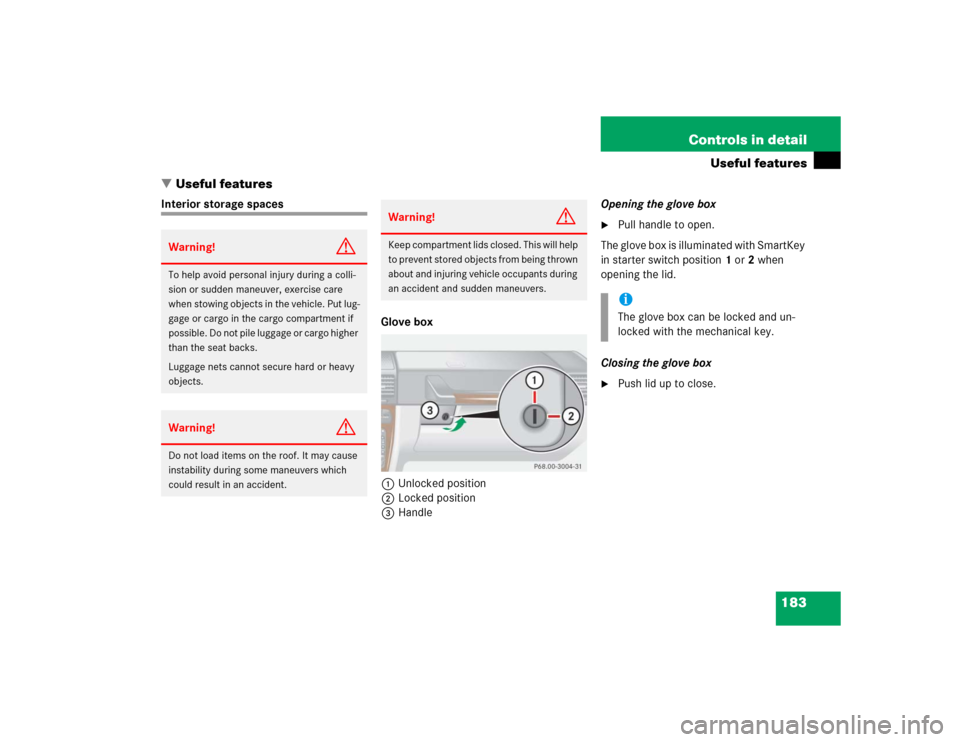
183 Controls in detail
Useful features
�Useful features
Interior storage spaces
Glove box
1Unlocked position
2Locked position
3HandleOpening the glove box
�
Pull handle to open.
The glove box is illuminated with SmartKey
in starter switch position1 or2 when
opening the lid.
Closing the glove box
�
Push lid up to close.
Warning!
G
To help avoid personal injury during a colli-
sion or sudden maneuver, exercise care
when stowing objects in the vehicle. Put lug-
gage or cargo in the cargo compartment if
possible. Do not pile luggage or cargo higher
than the seat backs.
Luggage nets cannot secure hard or heavy
objects.Warning!
G
Do not load items on the roof. It may cause
instability during some maneuvers which
could result in an accident.
Warning!
G
Keep compartment lids closed. This will help
to prevent stored objects from being thrown
about and injuring vehicle occupants during
an accident and sudden maneuvers.
iThe glove box can be locked and un-
locked with the mechanical key.